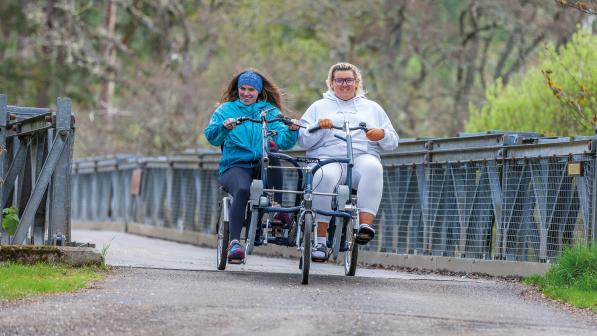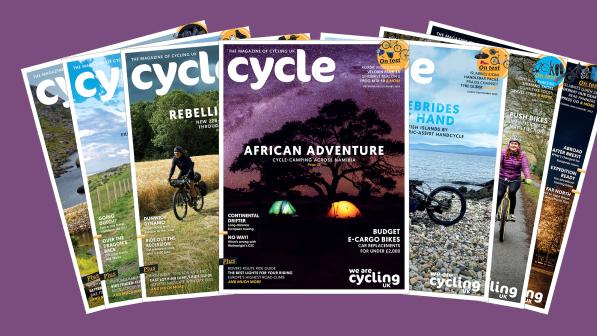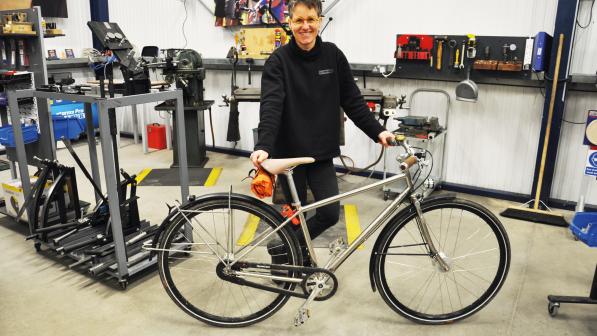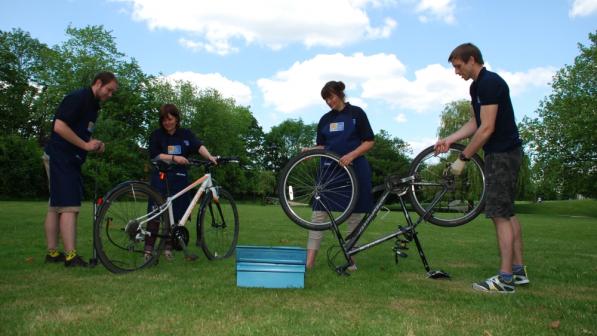Bicycles built to last

Building a bicycle requires raw materials, sophisticated machinery, skilled labour and energy. A typical bike burns up between a quarter and a third of a ton of carbon as it’s made. So it’s a great shame, as well as a terrible waste, if the lovely, shiny new bike displayed for sale fails to give years of service. Lots of bikes end up breaking down sooner than they should, and many are abandoned altogether as a result.
Bike recycling projects such as Cycling UK’s Big Bike Revival can get some of these bikes back into circulation. I experienced this during the Covid period. During lockdown, I was one of a dozen or so Cyclox volunteers in Oxford repairing donated bikes for key workers. Between us we put more than 450 bikes back on the road.
It could have been many more but for a few frequent faults that were too expensive for us to repair. One of the worst of these were worn bottom brackets. Punctures, corroded cables and worn-out chains were also pretty common but these were easy to fix. Even when worn bottom brackets could be repaired, the cost in time and resources usually exceeded our budget.
So how could bikes be designed to stand up better to usage, neglect and weather? My colleagues at Cyclox and I had some ideas, but I decided to ask some experts – bike makers who are aiming to make bikes that last.

Oxford Bike Works
Richard Delacour of Oxford Bike Works sets out to make bikes that can be used – and have been used – to cycle around the world. I asked him about his choice of components and how he’d arrived at them.
“A lot of it is trial and error,” he said, “learning from the feedback given by customers. Shimano is a dominant force in the gears and transmission market, and by and large, makes very reliable components. When I set up in business I took advice from seasoned cycle tourists who had tested components exhaustively.
“Nowadays, I have a reliable network of customers who let me know how they are getting on. I have a principle that if a component fails unexpectedly, I substitute it for something else straight away, so that I don’t end up knowingly fitting a component that has recently failed to another bike.
“Steel frames are much more resistant to fatigue than aluminium and carbon, and should last 20-30 years if looked after. Steel also has a certain springiness and the ability to absorb shocks, whereas other frame materials are stiffer and so riders are more likely to feel ‘road buzz’.”
Components wear at different rates, he said. “Chains and brake pads are the key items that wear out soonest. Shimano hubs last well. Cheap pedals often need replacing after a few thousand miles. Tyres can last a very long time – I had a customer cycle 14,000 miles from Singapore back to the UK on one set of Schwalbe Marathon Plus Tour tyres without any punctures. To date I have built 600 wheels and had only one spoke snap (that I know of).”
I asked him what he’d specify for a ‘forever bike’, capable of being ridden for thousands and thousands of miles with little or no maintenance. “My Expedition bike,” he said, “with a Rohloff hub, Magura rim brakes and a chain tensioner (so that I never had to re-tension the chain). A few pairs of brake blocks and some chain oil would be all that I needed.”
World Bicycle Relief
The next bike could hardly be more different. The Buffalo Bicycle (you can read more about it at worldbicyclerelief.org) is designed to serve the needs of people who travel long distances over rugged terrain with heavy cargo. It’s a very strong bicycle – the rack alone can take 100kg – built to withstand harsh rural conditions at a low cost. It’s designed for local maintenance and to use locally available spare parts. It’s made of steel, has a back-pedal coaster brake, a singlespeed gear and a stand that would not look out of place on a motorbike.
“Steel frames still provide the most value in terms of strength, cost and longevity,” World Bicycle Relief’s Lena Kleine-Kalmer told me. “A good steel frame will more or less last indefinitely in that it has a very good fatigue resistance and can be easily welded should it ever need a repair or modification. Steel welding capability is relatively common in the parts of the world where we operate, whereas aluminium welding is not. Threaded interfaces, such as the bottom bracket shell, are much easier to damage on an aluminium frame than a steel frame. As such, steel is a better choice for bikes with a very long life that will be serviced many times.”
Hub gears are usually thought of as long lasting and reliable but the Buffalo is a singlespeed. “No commercially available gear hub lasts very long in our markets,” said Kleine-Kalmer. “We have experimented with hub gears but while they provide good function, at least initially, they are very difficult to service and most of them rely on cables for shifting and require adjustments to maintain functionality. Internal gear hubs (IGH) need higher precision manufacturing processes, cost more and may not be robust and durable for heavy-duty usage.
The Buffalo is a singlespeed. No commercially available gear hub lasts very long in our markets
Lena Kleine-Kalmer, World Bicycle Relief
“Many of our riders are using their bikes all day, every day for many years, often carrying very heavy loads. What generally doesn’t need attention are the frames, forks and carriers. The primary source of failure is with rotational components under load: hubs, drivetrain and bottom brackets. Basically, anything with a bearing. The Buffalo uses a mixture of sealed bearings (bottom bracket) and serviceable bearings in the hubs.
“Sealed bearings can be a double-edged sword in that unless they are perfect seals (which they often aren’t) they can often retain water and contamination that inevitably works its way in over time. We have found that in many cases a shielded bearing that can keep out most of the contamination but allows water to drain out works well. In some cases, we have upgraded the bearings, either in quantity of balls used or in the hardness of the bearing races.”
As well as providing bikes, World Bicycle Relief works to improve the infrastructure. They train mechanics and, where the available spare parts are inadequate, they seek to improve distribution and access through their network of trained mechanics and a growing network of local shops.

Islabikes
It is perhaps too much to ask for a bicycle to last forever, but it does seem possible for bikes to be designed with repair and refurbishment in mind, so that bicycles can last for decades and their use can be far more sustainable than it is currently.
Four years ago Islabikes had just this possibility in mind when it set out on its Imagine Project. The project’s plan is to make a bicycle that can be manufactured in the UK, ridden to school and back for 50 years by as many children as possible and, at the end of the bike’s life, separated into usable materials.
Islabikes’ MD, Tim Goodall, told me that even the company’s ‘ordinary’ bikes were enjoying a long use-life. “When 15-plus years is considered long lasting, our bikes are long lasting,” he said. “I put it that way because 15 years is and was considered long lasting for children’s bikes. We’re in our 17th year now and many of our first bikes are still going strong, and many will likely be around in another 17 years if they are maintained. However, we still look for ways to make the bikes more durable without compromising performance, because 15 years is still nano seconds when we’re considering the longevity of our planet.”
Unlike the previous examples, Islabikes are usually made of aluminium. “All our frames are made from aluminium, and our forks are made of aluminium, chromoly or carbon fibre. The main reason for choosing aluminium is its light weight, although it’s also more resistant to corrosion than comparably priced steels. The weight increase of the bike would be significant if frames were made of steel, especially for children. We’ve avoided carbon in any volume (a few of our forks are made of it) in part because of the difficulties in recycling it, and there are still many improvements we can make to aluminium frames to make them lighter and improve the ride characteristics.”
Because Islabikes are designed for children, many components are nonstandard. “We design many of our components from the ground up, so what might appear to be just another bicycle pedal on a child’s bike has in fact been the result of a year-long development process. To make the design decisions – dimensions, materials, features – we combine available data on body sizing with our own observations and expertise.
“All components not designed by us are chosen with performance and longevity in mind, not what is fashionable. For example, fewer gears often means reduced weight and longer life at similar price points. We also fit sealed loose ball bearing hubs where possible, as with regular serving these will easily last the life of the bike.”
But even with bespoke design and choosing for longevity, parts do wear out. “Handlebar grips are among the first parts to wear, or chains. In the case of chains, they’ve usually not worn out, they’ve just gone rusty because they are not being oiled.”
When I asked him about building a ‘forever bike’, Goodall stressed the importance of serviceability and the availability of spares. “Keeping weight down would still be a high priority… It would be quite easy to create a bike that can go 10,000-20,000km between services but it would not be very efficient or fun to ride!
It would be quite easy to create a bike that can go 10,000-20,000km between services but it would not be very efficient or fun to ride!
Tim Goodall, Islabikes
“Adding additional rubber to tyres to get more miles out of them before they needed changing, for example, is possible but then the increased weight will create a bike that is slow to accelerate and climb hills on. Increasing chain width and sprocket thickness will extend the life of the drivetrain but increases weight and reduces the efficiency.
“It’s the same effect as how a car will go 10,000-20,000km between service but a lorry will do 80,000km. The lorry is expensive, inefficient and not very fun to drive… but you can rack up a lot of miles without having it serviced!”
Going further
So where does all this leave us? If we want bikes that are a joy to ride, that are light and that have variable gears, we have to accept the need for maintenance. But bikes can be made to be robust and long lasting if good-quality materials are used in the critical points such as the bottom bracket.
While manufacturers might not build ‘ordinary’ bikes as well as we would like, the higher demands that e-bikes make of transmission systems and brakes are already resulting in manufacturers being forced to equip these bikes with tougher components. Some of these parts can be used on a conventional bike when it’s time to replace gears and chains – those parts we expect to wear out – extending the time between services.





